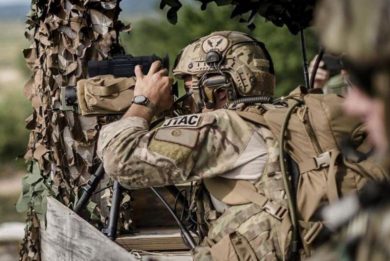
Italian Air Force + Leonardo = International Flight Training School, a successful cooperation between military and industry
In late May 2025 EDR On-Line was invited to visit the International Flight Training School in Decimomannu. Hereafter our readers can find an introductory test that depicts the evolution of the school, followed by specific articles on infrastructures, syllabus, simulation, the view from the users and the vuew from the industry.

In mid-2018 a Letter of Intent between the Italian Air Force and Leonardo was signed during Farnborough Air Show, the aim being to develop a flight training school under a public-private partnership-style funding model, the operation being named the International Flight Training School, IFTS in short. The aim was to leverage the experience acquired by the Italian Air Force in training allied and foreign pilots, a role assigned to the 61st Wing based at Lecce-Galatina Air Base, in southern Italy, and provide a state-of-the art system dedicated to Phase IV training, also referred to as LIFT, for Lead In Fighter Training, the last phase of training before being assigned to an Operational Conversion Unit and fly the actual fighter. The target is to increase the output level of Phase 4 skills thanks to a training system that exploits constructive systems (computers), virtual systems (simulators) and live systems (aircraft), the latter ensuring high performances at costs way lower than those of real fighters, to reduce the time, and cost, of the Operational Conversion Unit training; the whole system was to be built around the Leonardo M-346 Lead-In Fighter Trainer.

Six months after the signature, in mid-February 2019, the first two new Leonardo’s M-346 aircraft earmarked for the IFTS, joined the other 18 Italian Air Force’s T-346As (as the Air Force calls them) on the 61st Wing’s base, one of Leonardo’s contributions to the IFTS. More information on the IFTS programme were provided in June 2019, at the Paris Air Show.
In mid-December 2020 the groundbreaking ceremony of the future IFTS campus took place at Decimomannu, the air base located in Sardinia, selected to host the new school. Decimomannu has a tradition of international presence [1] and currently also hosts the Italian Air Force Reparto Sperimentale e di Standardizzazione Tiro Aereo (RSSTA), which carries on experimental and standardisation activities related to air weapons training.

March 2021 marked the creation of the Advanced Jet Training 50/50 joint venture between Leonardo and CAE, responsible for the support of all IFTS activities except for the actual training, which remains the responsibility of the Italian Air Force. In June 2021 the IFTS started its courses at Lecce-Galatina, the Decimomannu facility in Sardinia being still under construction. One year later, in July 2022, Phase 4 courses were moved to Sardinia, all activities related to that phase being shifted to the new base in early 2024, the IFTS reaching the Full Operational Capability. In July 2024 Leonardo obtained the AMO (Approved Maintenance Organization) certification, and in April 2025 the CAMO (Continuing Airworthiness Management Organisation) certification. At this time, pilots from 11 nations were training at the IFTS, two more nations pilots being expected shortly. And more to come.
The IFTS operates from the Decimomannu Air Base but is not the only unit to be deployed on the Sardinian airport. The operational arm of the IFTS is 212 Squadron, which is part of the 61st Wing. The latter falls under the Air Force School Command, headquartered in Bari. On the other hand, the aforementioned RSSTA is part of the Air Force Logistic Command, headquartered in Rome, the RSSTA commander being the base commander. Coordination between the two entities is working well, trainees being able to see on the base from time to time those types of aircraft they will soon be using operationally, a further motivation to complete the course with the highest gradings.
[1] From the early 1960s until the end of the century Decimomannu became a trinational Air Weapons Training Installation, initially funded by Italy, Canada and Germany, Canada being then replaced by the United Kingdom. An ACMI (Air Combat Manoeuvring Instrumentation) was installed on the western coast of Sardinia; pods fitted to combat aircraft allowed to simulate dogfights, record all actions, and replay them during debriefings at base. This attracted aircraft from numerous other nations. Moreover, thanks to the availability of firing ranges, during major NATO exercises the base apron hosted aircraft of many types, including intelligence and surveillance. The base is therefore used to see flags of many nations flying on its flagpoles. Modern simulation technologies and the distributed availability of ACMI, together with the geopolitical situation that followed the end of the Cold War, meant that until the advent of the IFTS the international presence at Decimomannu had considerably decreased.
Photos by P. Valpolini

IFTS, a state-of-the-art campus and infrastructure

International Flight Training School: Phase 4 training, Italian style

Simulation, at the heart of the International Flight Training School

IFTS, the word to the users




